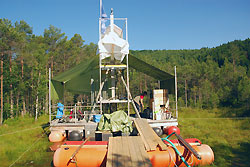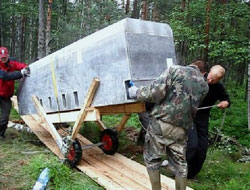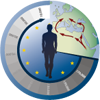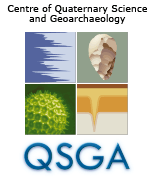In June/July 2014, our team (Maria Papadopoulou, Marc Bormann, Daniel Veres, Enikö Magyari and Frank Schäbitz) retrieved several metres of glacial sediments from two drilling locations within the Mohoş peat bog with the help of Richard Niederreiter and his equipment. Additionally, the Holocene bog sediments were recovered using a Russian Corer.
In order to bring the coring machinery and the platform to the coring site, our team, with the help of the park rangers, constructed a plank path over the bog. For the transportation of the equipment, the "Wagerl" was our strongest and most feared weapon. Nonetheless, it was our only means to transport the large floating tanks and the heaviest parts of the coring platform over the swampy terrain.
Our coring shows that Mohoş was a bog only in the Holocene. During the glacial, clay deposits suggest that the area was occupied by a lake. The lacustrine clays were dry and compacted and inter-bedded with tephra layers. Consequently, the lake clays and some of the tephra layers were very hard to penetrate even with the strong mechanical equipment that we possessed. In the field, we were able to identify clay layers that were purely deep lacustrine clays as well as layers enriched with silt and fine sand.
The sediment cores have been shipped over to Cologne by end of July, where in the following months they will be split, described and analyzed. Our first age estimations based on tephrostratigraphy suggest that the material from Mohoş covers the time of the first appearance of modern humans in the region during the last glacial.
 Coring platform at Mohoş peat bog. Coring platform at Mohoş peat bog.Photo: Marc Borman |
 The "Wagerl" with floating tank (from left to right: Frank Schäbitz, Levi and Daniel Veres). Photo: Maria Papadopoulou |
















